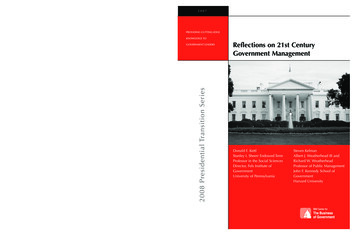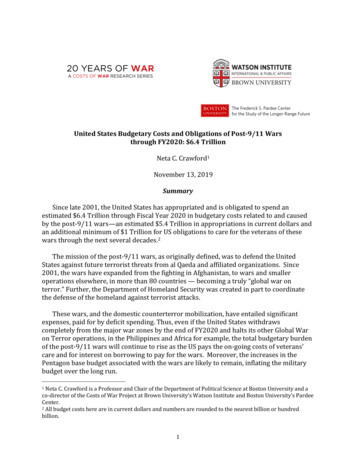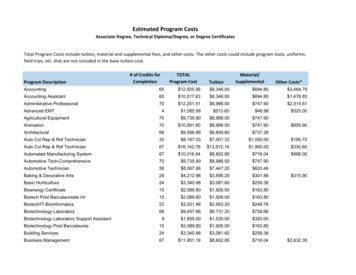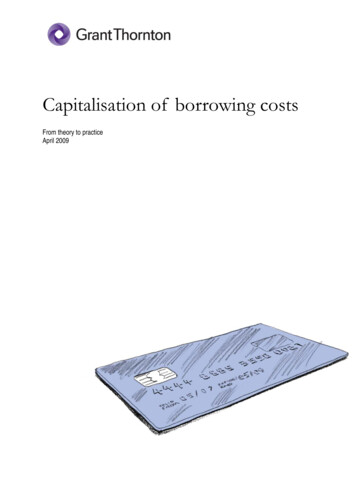
Transcription
Costs and benefitsof government borrowingin foreign currency: is ita major source of risk forEU member states outsidethe Euro?MISLAV BRKIĆ, univ. spec. oec.*Review article**JEL: E52, E58, F34, H63https://doi.org/10.3326/pse.45.1.2The author would like to thank Igor Ljubaj and two anonymous reviewers for providing useful commentsduring the preparation of this paper. The views and opinions expressed in this article are those of the authorand do not necessarily reflect the official policy or position of the Croatian National Bank.** Received: June 16, 2020Accepted: November 10, 2020* Mislav BRKIĆCroatian National Bank, Trg hrvatskih velikana 3, 10000 Zagreb, Croatiae-mail: mislav.brkic@hnb.hrORCiD: 0000-0003-3872-4824
64public sectoreconomics45 (1) 63-91 (2021)AbstractThis paper discusses the costs and benefits of government borrowing in foreigncurrency. While discussing the main costs, such as increased exposure to currencyand rollover risks, and limited capacity to respond to financial crises, this paperalso identifies two benefits of foreign currency borrowing. The paper also exploresto what extent governments of non-euro area EU member states rely on foreigncurrency borrowing and whether they have sufficient capacity to preserve currency stability in the event of adverse shocks. The analysis suggests that the publicfinances of these countries are not heavily exposed to currency risk. Exceptions tothis are Bulgaria and Croatia, whose government debt is mainly denominated ineuros, and who also suffer from high loan and deposit euroization. It is thereforenot surprising that they are the first two among the remaining non-euro area EUmember states to take steps towards the introduction of the euro.MISLAV BRKIĆ: COSTS AND BENEFITS OF GOVERNMENT BORROWINGIN FOREIGN CURRENCY: IS IT A MAJOR SOURCE OF RISKFOR EU MEMBER STATES OUTSIDE THE EURO?Keywords: foreign currency, government debt, international reserves, debt crisis,dollarization1 INTRODUCTIONSince the 1970s, it has been illustrated many times that government borrowing inforeign currency can be a major source of risk. Not only does it tend to create currency mismatches and thus expose public finances to exchange rate shocks, but itcan also make refinancing of government debt more challenging. In particular, beingaware that the government suffers from a currency mismatch, investors can be verysensitive to changes in the country’s risk profile. If the risk profile deteriorates,investors may choose to withdraw from its bonds to avoid losses that could occur ifthe government runs out of foreign currency. In such a context, it can becomeincreasingly difficult for the government to refinance its foreign currency liabilitiesas they mature. Therefore, if the government is heavily indebted in foreign currency,it becomes vulnerable to self-fulfilling prophecies: investors’ worries about a defaultcould easily result in the country actually defaulting on its debt.Although economic history has clearly taught us that borrowing in foreign currency can be very harmful to macroeconomic stability, even today many countriesrely heavily on foreign currency sources of funding. One of the objectives of thispaper is to explain why this is so. In addition to discussing the costs and risks, itidentifies two main benefits of government borrowing in foreign currency, whichare most evident in small, highly dollarized emerging market countries. One ofthese benefits is that funding sources in major global currencies are typically moreabundant and cheaper than local sources of funding in domestic currency. Therefore, in countries where local funding sources are scarce, external borrowing bythe government, if allocated to productive projects, can be an important driver ofeconomic growth and development. The second benefit stems from the fact thatgovernment borrowing in foreign currency enables the central bank – at least temporarily, as the debt stock is increasing – to accumulate foreign exchange reservesthat serve as a backstop for the domestic currency. To illustrate this point, the
paper shows that government borrowing in foreign currency accounted for almost40% of the cumulative increase in Croatia’s foreign exchange reserves over thelast two decades.The structure of the paper is as follows. Chapter 2 discusses the main disadvantages and some advantages of government borrowing in foreign currency from theperspective of emerging market countries, taking into account specific features oftheir economies. Chapter 3 reviews the literature to identify how a country thatrelies heavily on foreign currency funding can minimize the risk of a currency anddebt crisis. Chapter 4 looks into the currency composition of government debt andother macroeconomic fundamentals of non-euro area EU member states to determine whether foreign currency borrowing is a major source of risk for these countries. Chapter 5 concludes the paper.MISLAV BRKIĆ: COSTS AND BENEFITS OF GOVERNMENT BORROWINGIN FOREIGN CURRENCY: IS IT A MAJOR SOURCE OF RISKFOR EU MEMBER STATES OUTSIDE THE EURO?The main contribution of this paper is that it provides a nuanced overview of thecosts and benefits of government borrowing in foreign currency. While borrowingin foreign currency makes a country vulnerable and therefore should be avoided ifpossible, the paper shows that in some specific cases – such as when the financialsystem is highly euroized (dollarized) – this can actually be beneficial from thefinancial stability perspective. In addition, based on an analysis of the currencycomposition of government debt in EU member states outside the euro area, thepaper suggests a potential explanation for why some of these countries are eagerto adopt the euro while others are not.public sectoreconomics45 (1) 63-91 (2021)The second objective of this paper is to explore to what extent governments ofnon-euro area EU member states rely on foreign currency borrowing, and whetherthey have sufficient capacity to preserve currency stability in the event of a negative shock. The analysis suggests that public finances of these countries are notheavily exposed to currency risk. In most countries, a large majority of outstanding government debt is denominated in domestic currency, leaving public financeslargely isolated from exchange rate fluctuations. Exceptions to this are Bulgariaand Croatia, whose government debt consists mainly of euro-denominated liabilities. Given their relatively higher exposure to currency risk, it is not surprisingthat Bulgaria and Croatia are the first among the remaining non-euro area EUmember states to take concrete steps towards the introduction of the euro. However, even these two countries seem to have contained currency risk with theirgenerally strong fiscal and external fundamentals. This was demonstrated in 2020after the outbreak of the COVID-19 pandemic, when both countries managed tokeep their currencies stable despite the adverse economic impact of the necessarydisease containment measures.65
662 COSTS AND BENEFITS OF GOVERNMENT BORROWING IN FOREIGNCURRENCY2.1 COSTS OF FOREIGN CURRENCY BORROWING2.1.1 Exposure to currency riskpublic sectoreconomics45 (1) 63-91 (2021)Unhedged foreign currency borrowing is risky because it makes the borrower sensitive to exchange rate fluctuations. If a government borrows in the markets in foreigncurrency, while generating (tax) revenue exclusively in domestic currency, it will bevulnerable to a potential depreciation of the domestic currency. In the event of adepreciation, the government debt-to-GDP ratio will become larger, while interestexpenditures will also increase, negatively affecting the budget balance. If the government, companies and households are indebted in foreign currency at the sametime, the entire economy will be heavily exposed to currency risk.MISLAV BRKIĆ: COSTS AND BENEFITS OF GOVERNMENT BORROWINGIN FOREIGN CURRENCY: IS IT A MAJOR SOURCE OF RISKFOR EU MEMBER STATES OUTSIDE THE EURO?There is a vast literature dealing with the causes and consequences of unhedgedforeign currency borrowing. In an influential paper, Eichengreen and Hausmann(1999) note that most developing countries are unable to issue external debt indomestic currency, so they have no other option but to issue debt securitiesdenominated in one of the key global currencies. The inability to borrow abroadin domestic currency is what these authors call “the original sin”, because it generates currency mismatch at the aggregate level, which represents a major constraintfor policy makers. In particular, in the context of high exposure to currency risk,preserving the stability of the domestic currency usually becomes a top policypriority for the central bank. A strong focus on currency stability, however, narrows the space for flexible use of monetary policy, as remaining policy objectives,such as managing the business cycle, become less important (Eichengreen, Hausmann and Panizza, 2003). As a result, countries that borrow in foreign currencytend to have a higher degree of macroeconomic volatility than those that borrowmainly in their own currency.The impact of currency depreciation on public finances is very straightforward. Ifpart of the government debt is denominated in or indexed to foreign currency, thatpart will mechanically increase (expressed in domestic currency) in line with thestrengthening of the foreign currency, generating a step increase in the debt-toGDP ratio (figure 1). In addition, annual interest expenses will increase due to thenow higher debt stock, even if the average interest rate is unaffected. However, itis very likely that, following a large depreciation of the currency, the country’srisk premium would rise, making new government borrowing costlier. This wouldproduce second-round effects because a higher average interest rate would entaileven higher interest expenses, with an adverse impact on the government budgetbalance and the debt trajectory.
67Figure 1Impact of a currency depreciation on the public financesa) Government gross debt, in % of 0-2.0-2.4-3.0a 30 %depreciation45a 30 %depreciation-1.5-3.1-3.5-4.040t-2t-1t0t 1t 2t 3t 4-4.5public sectoreconomics45 (1) 63-91 (2021)60.56050b) Government balance, in % of GDP0.070t-2t-1t0t 1-3.7-3.8-3.9t 2t 3t 4Source: Author.What could cause currency depreciation in a country that is heavily borrowing inforeign currency? Several factors can lead to such an outcome, with banking system fragility being one of the most common triggers.1 Specifically, if banks havelarge, uncovered short-term foreign currency liabilities, the decision of creditorsand depositors to call on their loans and withdraw their deposits will put a strainon the banks’ limited stocks of liquid foreign currency assets (Chang and Velasco,1999). Due to the shortage of foreign currency relative to domestic currency, thedomestic currency would depreciate, forcing the central bank to deploy international reserves in an attempt to stabilize the currency. An extreme example of sucha scenario was the financial crisis in Iceland in 2008. This event clearly demonstrated how an oversized and poorly regulated banking system could bring downthe currency and the economy as a whole (Claessens, Herring and Schoenmaker,2010). Furthermore, currency depreciation may occur if investors, concernedabout the country’s deteriorating macroeconomic fundamentals2 or inflated assetprices, begin to liquidate their positions in government bonds and other domesticcurrency-denominated securities. The risk of a destabilizing sell-off of domesticcurrency assets is less pronounced in countries with shallow capital markets. Inthese countries, the supply of securities denominated in domestic currency isKaminsky and Reinhart (1999) empirically investigated the link between banking and currency crises. Theyfound that banking and currency crises often coincide, with the banking typically preceding the currency crisis. The currency crisis in turn aggravates the banking crisis, creating a vicious circle with an adverse impacton the real economy. However, although banking crises usually start before currency crises, they are not necessarily the immediate cause of currency crises. In fact, two crises are sometimes manifestations of the sameroot cause – excessive credit growth backed by favourable access to international financial markets.2Frankel and Rose (1996) found that the likelihood of a currency crisis is high when international reserves aremodest, the share of FDIs in total external debt is low, the real exchange rate is overvalued, credit growth isstrong and interest rates in the advanced economies are rising. Most of these variables are identified as critical also by Sachs, Tornell and Velasco (1996).1MISLAV BRKIĆ: COSTS AND BENEFITS OF GOVERNMENT BORROWINGIN FOREIGN CURRENCY: IS IT A MAJOR SOURCE OF RISKFOR EU MEMBER STATES OUTSIDE THE EURO?Note: The simulation is performed assuming that the initial debt-to-GDP ratio is 50%, the primary deficit is zero, the share of foreign currency debt in total government debt equals 70%, thenominal GDP growth rate is 4%, while the weighted nominal interest rate on debt, initially setat 4%, increases following the depreciation of the currency to 5% in t 1, and further to 6% int 2, remaining stable thereafter.
68limited, so there is little risk that transactions in the securities market will exertstrong downward pressure on the currency.2.1.2 Increase in refinancing riskpublic sectoreconomics45 (1) 63-91 (2021)MISLAV BRKIĆ: COSTS AND BENEFITS OF GOVERNMENT BORROWINGIN FOREIGN CURRENCY: IS IT A MAJOR SOURCE OF RISKFOR EU MEMBER STATES OUTSIDE THE EURO?Apart from giving rise to currency risk, foreign currency borrowing is associatedalso with greater refinancing (rollover) risk. In fact, these two risks are mutuallyreinforcing. The former risk tends to exacerbate the latter, in the sense that a largepresence of currency risk may trigger the materialization of refinancing risk. Thelink is quite intuitive: if a government borrows in foreign currency, its creditorswill be indirectly exposed to currency risk, because a sharp depreciation of thedomestic currency may reduce the government’s ability to meet its foreign currency obligations.3 Therefore, in the event that creditors suspect that the borrower’s currency might lose ground, they would no longer be interested in financingthe borrower. As a result, the government would be forced to repay its foreigncurrency liabilities as they fall due, which, if large sums have to be repaid withina short time period, could lead to a debt and currency crisis. In such a case, theonly remaining option for the government – if it wants to avoid defaulting on itsforeign currency debt – would be to seek international financial assistance.There are numerous historical examples of debt crises caused by excessive foreigncurrency borrowing. Indeed, financial crises in emerging market countries areusually preceded by periods of abundant inflow of foreign currency funding.Namely, if global financial conditions are favourable, emerging market countrieswill have an incentive to import capital from abroad to finance domestic consumption and investment at low cost. The favourable impact of externally fundedspending on output and employment will reflect positively on consumer and business confidence and thus lead to an even higher propensity to borrow and spend.If left unaddressed, excessive external borrowing might lead to an unsustainableexpansion of domestic demand and leave the economy vulnerable to externalshocks. As these shocks tend to emerge abruptly, emerging market countries areoften caught by surprise. External shocks can take various forms, ranging fromsudden changes in global monetary conditions, deteriorating investor confidence4,falling prices of the main export commodities, to main trading partners announcing protectionist measures5. Irrespective of the type of the external shock, theshock usually leads to a deterioration in the borrowing country’s access to externalfinancing. The most widely known examples of such events are the crises in LatinAmerica in the 1980s and 1990s.3This risk is often referred to as foreign currency-induced credit risk because the materialization of currencyrisk on the side of the borrower leads to the materialization of credit risk for the creditor.4A deterioration in investor confidence may concern a single country or a group of countries sharing similarcharacteristics. A notable example of a broad-based confidence shock was the so-called “taper tantrum” ofMay 2013. As the Federal Reserve announced that it was considering winding down its program of unconventional monetary policy measures, a sudden reassessment of global risk premiums took place, which had anegative effect on several emerging market economies that were vulnerable at the time due to elevated macroeconomic imbalances (Sahay et al., 2014).5For instance, in November 2016 the Mexican peso depreciated sharply against the dollar following Donald Trump’s victory in US presidential elections, as investors feared that the new President would keep hiscampaign promise to revise the North American Free Trade Agreement (NAFTA) (Banco de Mexico, 2017).
Vulnerability to recurrent debt and currency crises are not an exclusive feature ofthe modern globalized economy characterized by flexible exchange rates andextensive cross-border financial flows. These disruptive events have occurredfrom time to time throughout history, even when the entire world relied on fixedexchange rates and when gross capital flows were subdued by modern standards.A notable case is the default of Germany from the early 1930s. Germany hadreturned to the gold standard by the mid-1920s, after which it borrowed heavily inforeign currency, mainly to obtain the gold and convertible currencies needed tosettle large reparations following its World War I defeat (Ritschl, 2013). In 1929,a revised, much more demanding reparations agreement was announced, whichraised concerns among creditors and resulted in Germany losing access to externalfinancing. The outbreak of the Great Depression further exacerbated the alreadydire situation. Confronted with large refinancing needs and a rapid loss of international reserves, in 1931 the German central bank imposed capital controls. Finally,in 1933, Germany declared a default on most of its foreign liabilities.MISLAV BRKIĆ: COSTS AND BENEFITS OF GOVERNMENT BORROWINGIN FOREIGN CURRENCY: IS IT A MAJOR SOURCE OF RISKFOR EU MEMBER STATES OUTSIDE THE EURO?Heavy government borrowing in foreign currency was also a major factor behindthe 1994 Mexican crisis. In light of Mexico’s pronounced macroeconomic imbalances and large refinancing needs on the domestic front, and deteriorating globalmonetary conditions on the external front, investors were worried that the Mexican authorities would be unable to defend the peso from depreciating. These fearswere further exacerbated by domestic political instability, which culminated inlate 1994, triggering significant capital outflows (IMF, 2012). The liquidity crisissoon transformed into a currency and debt crisis, prompting Mexican authoritiesto seek financial assistance from the US and IMF.69public sectoreconomics45 (1) 63-91 (2021)The debt crisis in Latin America in the early 1980s was a consequence of the borrowing spree that took place during the previous decade. In the 1970s, countriessuch as Argentina, Brazil and Mexico borrowed heavily abroad in US dollars tocover their large balance of payments needs. By the late 1970s, it had becomeclear that the rapid accumulation of debt was not sustainable and that externaladjustment was needed (Federal Deposit Insurance Corporation, 1997). Despitethat, foreign banks, especially those from the US, continued to increase their lending to the region. The situation, however, changed dramatically at the beginningof 1980s, when the Federal Reserve (Fed) tightened monetary policy to combathigh inflation in the US. This had a devastating impact on the heavily indebtedLatin American countries. Not only did interest rates on their foreign liabilitiesincrease, but also their national currencies depreciated considerably against theUS dollar, increasing the repayment burden of large stocks of US dollar liabilities.While most Latin American countries continued to service their liabilities withoutdefaulting, the heavy repayment burden contributed to a deep and prolongedrecession, which lasted for most of the decade.
702.1.3 Reduced ability to tackle financial crisespublic sectoreconomics45 (1) 63-91 (2021)The episodes of debt crisis documented above illustrate how excessive foreigncurrency borrowing can make countries vulnerable to self-fulfilling prophecies.6The vulnerability to sudden shifts in investor confidence stem from the borrowingcountry’s inability to create the foreign currency needed to repay the creditors ifmany of them decide to withdraw funding at the same time. In contrast, countrieswith the privilege of borrowing exclusively in domestic currency do not sufferfrom the same weakness.MISLAV BRKIĆ: COSTS AND BENEFITS OF GOVERNMENT BORROWINGIN FOREIGN CURRENCY: IS IT A MAJOR SOURCE OF RISKFOR EU MEMBER STATES OUTSIDE THE EURO?While borrowing in domestic currency does not eradicate the risk of a debt crisisaltogether, it indirectly enables the country to cope better with the crisis should itoccur. In particular, if both the government and the private sector borrow mainlyin domestic currency, the central bank will be less concerned about exchange ratefluctuations. Owing to this, the central bank will be able to lend freely to commercial banks in times of crisis to contain liquidity disruptions. Liquidity disruptions are very common during sovereign debt crises, as depositors may becomeconcerned about the possible adverse impact of the crisis on bank solvency. Byacting as lender of last resort, the central bank provides fundamentally healthybanks with additional cash needed to meet the increased withdrawal requests. Thisnot only helps cure liquidity problems in the banking system, but it also enablesthe government to refinance its debts with commercial banks at favourable terms.The European sovereign debt crisis of 2010-2012 has shown very clearly that central bank emergency lending can have an instrumental role in containing the falloutfrom the crisis. At the height of the sovereign debt crisis, the Eurosystem – consisting of the ECB and the euro area national central banks – provided massive amountsof liquidity to Greek, Irish, Portuguese and Spanish banks, which had almost completely lost access to market funding (figure 2). There is no doubt that the debt crisisin Europe would have been much worse had the Eurosystem not intervened to prevent the collapse of peripheral countries’ banking systems. In addition to enhancedliquidity provision to banks, which indirectly assisted the vulnerable governmentsto obtain the much needed funding, the Eurosystem implemented several measuresaimed directly at tackling the turmoil in the sovereign debt market.7The ECB’s virtually unlimited capacity to act as crisis manager came into focusagain in 2020 after the outbreak of the COVID-19 pandemic. While memberstates initially failed to reach an agreement on a common fiscal response to thecrisis, by mid-March 2020, the ECB had already stepped in by announcing thePandemic Emergency Purchase Programme (PEPP) worth EUR 750 billion.8There is a large body of literature dealing with the vulnerability of emerging market countries to self-fulfilling panics (Obstfeld, 1986; 1994; Eichengreen, Rose and Wyplosz, 1995; Flood and Marion, 1996; Coleand Kehoe, 2000).7For a review of unconventional policy measures of the ECB, see Constancio (2012), Gros, Alcidi and Giovanni (2012) and Micossi (2015).8In June 2020, the ECB decided to scale up the total size of the program from EUR 750 billion to EUR 1,350billion.6
Figure 2Borrowing from the Eurosystem as percent of banks’ total liabilities71public sectoreconomics45 (1) 63-91 (2021)Under this program, the ECB has been purchasing large amounts of euro areapublic and private sector securities each month in order to prevent borrowingcosts from increasing significantly. Such an intervention by the ECB was criticalin the acute phase of the crisis as it eased pressures on the countries particularlyaffected by the pandemic and enabled their governments to finance healthcarespending and economic relief programs at low cost. Central banks of otheradvanced countries took similar actions in response to the crisis.35Demiseof landSources: ECB SDW; author’s calculation.The capacity of the central bank to tackle financial crises is much lower in countries where liabilities of the government and other sectors are mainly denominatedin foreign currency. There are at least three reasons for this. First, if governmentdebt is denominated mainly in foreign currency and the government experiencesrefinancing difficulties, the central bank can provide support only to a limiteddegree, as it can only create domestic currency.9 Second, if liabilities of commercial banks, such as deposits and received loans, are largely denominated in foreigncurrency, the provision of domestic currency liquidity by the central bank will fallshort of mitigating liquidity disturbances in the banking system. What banks needin case of liquidity disturbances is foreign currency.10 Third, in dollarized countries, massive purchases by the central bank of government bonds or heavy lending to commercial banks in local currency would be imprudent as it could fuel9The capacity of the central bank to support government debt in foreign currency is limited by the size of itsforeign exchange reserves. On the other hand, the capacity to intervene in domestic currency funding markets is not directly determined by the level of foreign exchange reserves. At the peak of the COVID-19 crisis,several emerging market central banks pursued unconventional monetary policies to support their economies,including the purchase of government debt securities denominated in domestic currency (IMF, 2020a). However, for such programs to be credible, the central bank should have comfortable foreign exchange reserves toassure financial markets that the newly created money will not lead to a currency devaluation.10The first thing the central bank will do in such a context is reduce the reserve requirement to release banks’own foreign currency liquidity buffers. If these buffers prove insufficient, the central bank may decide to sella portion of its foreign exchange reserves to banks through foreign exchange interventions or swap transaction. Obviously, the ability of the central bank to supply foreign currency to banks in this way is constrainedagain by the available stock of foreign exchange reserves (Chang and Velasco, 1998).MISLAV BRKIĆ: COSTS AND BENEFITS OF GOVERNMENT BORROWINGIN FOREIGN CURRENCY: IS IT A MAJOR SOURCE OF RISKFOR EU MEMBER STATES OUTSIDE THE EURO?25Beginningof the debtcrisis in Greece
72public sectoreconomics45 (1) 63-91 (2021)speculation against the currency and lead to a harmful depreciation of the exchangerate. Hence, in heavily dollarized countries, the ability of the central bank to act aslender of last resort is significantly weakened, and so is the ability of these countries to tackle banking and sovereign debt crisis on their own. In this respect,dependence on foreign currency borrowing could definitely be considered a“curse” because it makes the country both more likely to experience a financialcrisis and less capable of managing the crisis if one occurs.2.2 BENEFITS OF FOREIGN CURRENCY BORROWING2.2.1 Lower cost of financingMISLAV BRKIĆ: COSTS AND BENEFITS OF GOVERNMENT BORROWINGIN FOREIGN CURRENCY: IS IT A MAJOR SOURCE OF RISKFOR EU MEMBER STATES OUTSIDE THE EURO?Currency risk is non-existent and refinancing risk is typically lower when debtsare denominated in domestic currency. The question arises then why some borrowers decide to take on debts in foreign currency when it is far more risky thanborrowing in domestic currency. The main reason is that funding in major globalcurrencies, such as the US dollar and the euro, tends to be cheaper and more abundant, especially for small open economies. Specifically, if the domestic financialsector is relatively small, the local supply of financing may not be sufficient tosatisfy the overall demand for credit at a favourable cost. This may encourage thegovernment and other borrowers to seek cheaper financing abroad, either directly– by obtaining loans from foreign banks or issuing bonds in international markets,or indirectly – by borrowing from local banks that import capital to finance domestic lending. Since only a handful of countries are able to borrow abroad in theirown currencies, external borrowing in most cases results in increased exposure tocurrency risk.Moreover, even when borrowing takes place in the domestic market, debts areoften indexed to foreign currency. As Claessens, Schmukler and Klingebiel (2007)explain, small countries typically have limited local investor bases, and thus mayprefer issuing government securities linked to a major currency in order to attractforeign investors. The additional demand coming from foreign investors will likelyensure both greater availability and lower cost of funding for the government.Borrowing in foreign currency may facilitate investment and economic development to the extent that it provides the country with more affordable financing andthat the borrowed funds are channelled to productive sectors. In particular, if thecountry is underdeveloped, the government can borrow abroad to carry out productive i
relies heavily on foreign currency funding can minimize the risk of a currency and debt crisis. Chapter 4 looks into the currency composition of government debt and other macroeconomic fundamentals of non-euro area EU member states to deter-mine whether foreign currency borrowing is a major source of risk for these coun-tries.











